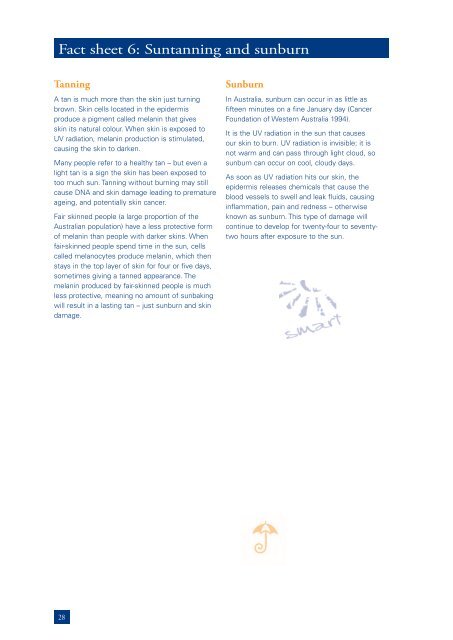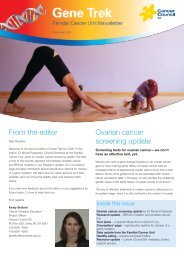Be SunSmart final print file.indd - Cancer Council SA
Be SunSmart final print file.indd - Cancer Council SA
Be SunSmart final print file.indd - Cancer Council SA
You also want an ePaper? Increase the reach of your titles
YUMPU automatically turns print PDFs into web optimized ePapers that Google loves.
Fact sheet 6: Suntanning and sunburn<br />
Tanning<br />
A tan is much more than the skin just turning<br />
brown. Skin cells located in the epidermis<br />
produce a pigment called melanin that gives<br />
skin its natural colour. When skin is exposed to<br />
UV radiation, melanin production is stimulated,<br />
causing the skin to darken.<br />
Many people refer to a healthy tan – but even a<br />
light tan is a sign the skin has been exposed to<br />
too much sun. Tanning without burning may still<br />
cause DNA and skin damage leading to premature<br />
ageing, and potentially skin cancer.<br />
Fair skinned people (a large proportion of the<br />
Australian population) have a less protective form<br />
of melanin than people with darker skins. When<br />
fair-skinned people spend time in the sun, cells<br />
called melanocytes produce melanin, which then<br />
stays in the top layer of skin for four or five days,<br />
sometimes giving a tanned appearance. The<br />
melanin produced by fair-skinned people is much<br />
less protective, meaning no amount of sunbaking<br />
will result in a lasting tan – just sunburn and skin<br />
damage.<br />
28<br />
Sunburn<br />
In Australia, sunburn can occur in as little as<br />
fifteen minutes on a fine January day (<strong>Cancer</strong><br />
Foundation of Western Australia 1994).<br />
It is the UV radiation in the sun that causes<br />
our skin to burn. UV radiation is invisible; it is<br />
not warm and can pass through light cloud, so<br />
sunburn can occur on cool, cloudy days.<br />
As soon as UV radiation hits our skin, the<br />
epidermis releases chemicals that cause the<br />
blood vessels to swell and leak fluids, causing<br />
inflammation, pain and redness – otherwise<br />
known as sunburn. This type of damage will<br />
continue to develop for twenty-four to seventytwo<br />
hours after exposure to the sun.



